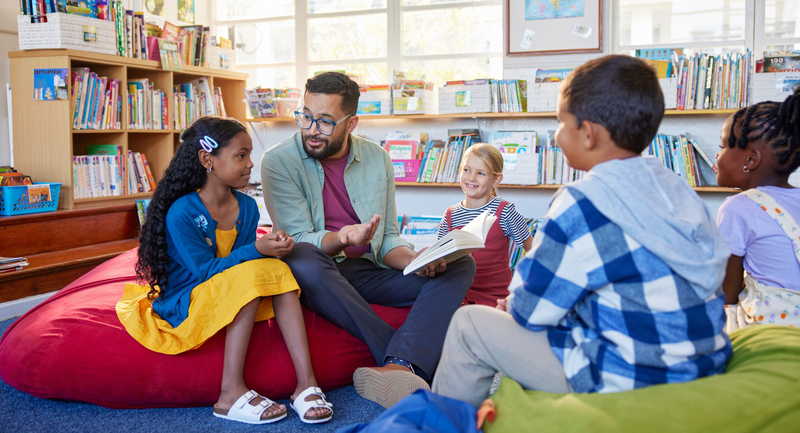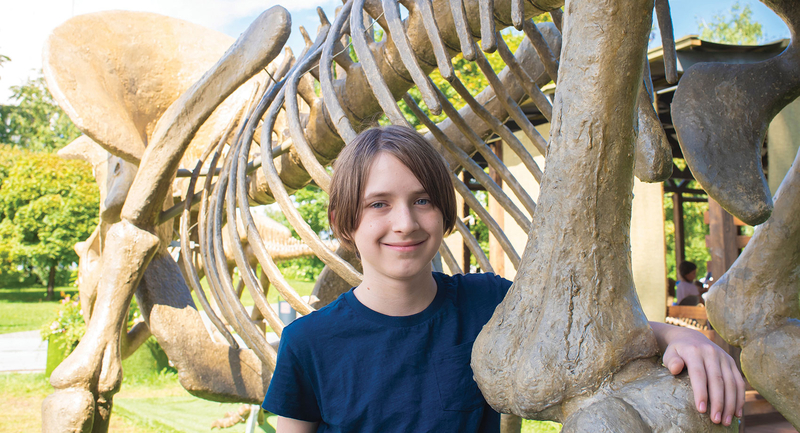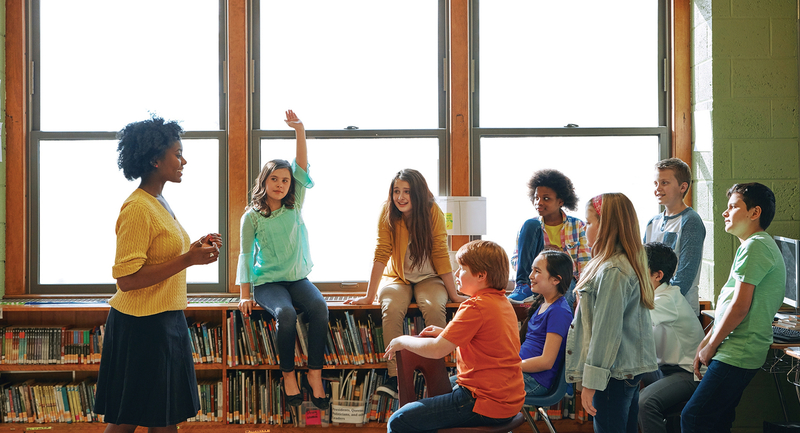Last summer 100 7th and 8th grade students got off buses in front of a chain-link fence where a nuclear warning sign was posted. In front of them was a grass-covered hill where thousands of cubic feet of thorium are buried. They were there to solve the “thorium waste problem.”
As part of a week-long Illinois Mathematics and Science Academy (IMSA) summer program, the students were taking the roles of scientists working for the Illinois Nuclear Regulatory Commission. After visiting the West Chicago site, surveying the community, and conducting experiments, they presented their solutions to state government experts, scientists, and community activists.
Not that the “thorium problem” is an easy problem to solve. On the contrary, it is an authentic problem and one fraught with controversy. Scientists do not agree about the health risks posed by the low-level nuclear materials. Activists want all the material moved somewhere else even if the solution bankrupts the company. And some members of the Illinois General Assembly want the thorium removed from the state even though there is no place in the country currently licensed to accept the material. The company believes entombing the thorium at the site is the best solution.
This is just one of the problem-based learning (PBL) units designed by the staffs at the Center for Problem-Based Learning and IMSA to increase students' achievement and motivation. Through problem-based learning, students learn how to use an iterative process of assessing what they know, identifying what they need to know, gathering information, and collaborating on the evaluation of hypotheses in light of the data they have collected. Their teachers act as coaches and tutors: probing findings, hypotheses, and conclusions; sharing their thinking when students need a model; and attending to metacognitive growth by way of “time out” discussions on how thinking is progressing.
These investigations of the connectedness and complexity of real-world problems nurture collaboration among learners, provide instructional tasks appropriately challenging for the targeted students, and promote performance assessments based upon the context of each learning situation.
What Is Problem-Based Learning?
Problem-based learning turns instruction topsy-turvy. Students meet an “ill-structured problem” before they receive any instruction. In the place of covering the curriculum, learners probe deeply into issues searching for connections, grappling with complexity, and using knowledge to fashion solutions. As with real problems, students encountering ill-structured problems will not have most of the relevant information needed to solve the problem at the outset. Nor will they know exactly what actions are required for resolution. After they tackle the problem, the definition of the problem may change. And even after they propose a solution, the students will never be sure they have made the right decision. They will have had the experience of having to make the best possible decision based on the information at hand.
They will also have had a stake in the problem. In problem-based learning students assume the roles of scientists, historians, doctors, or others who have a real stake in the proposed problem. Motivation soars because students realize it's their problem. By having a stake, they come to realize that no real-world problem is objective, that every point of view comes with a bias toward interpreting data in a certain way.
Teachers take on new roles in problem-based learning, too. First they act as models, thinking aloud with students and practicing behavior they want their students to use. They familiarize students with metacognitive questions such as, What's going on here? What do we need to know more about? What did we do during the problem that was effective? Then they coax and prompt students to use the questions and take on the responsibility for the problem. As time goes on, students become self-directed learners. To encourage the students' independence, the teachers then fade into the background and assume the role of colleagues on the problem-solving team.
In the process of problem solving, students crisscross a variety of disciplines. They build substantial knowledge bases through increasingly self-directed study. Through collaboration with their classmates, students refine and enlarge what they know, storing their new knowledge in long-term memory in such a way to promote transfer to new problems. As they move toward solutions, they identify conflicting ethical appeals. And when it is time for resolution, they present, justify, and debate solutions, looking for the “best fit.” Problem-based learning is apprenticeship for real-life problem solving.
Innovative Programs for Problem-Based Learning
Over the last three years, the Center for Problem-Based Learning at IMSA has been developing innovative programs incorporating problem-based learning into a variety of K–12 settings. As a research and development facility, the Center uses IMSA as a testing ground and also offers its services through partnership with other schools and institutions. Some special programs are funded by various private sector grants, including corporate and foundation donors.
One course developed at IMSA called Science, Society, and the Future is a semester-long elective for seniors that focuses on unresolved science-related social issues. The course is interdisciplinary and taught by a team of teachers, one from science and one from the social sciences. Students learn exclusively through the use of ill-structured problems.
One activity has seniors pondering patient files, searching for the cause of pneumonia contracted by 22 residents of a community of 20,000. Taking the roles of public health officials, they will soon discover the chilling fact that the bacterium L. pneumonphilia (Legionnaires' disease) has been found in the lungs of one of the patients. They will need to ask: What does this new information do to the problem? What is this agent like? What does it do to its hosts?
At the end of another week of investigation, the seniors are highly suspicious that a misting system in the produce section of a local supermarket may be the source of the outbreak. They have set time aside to talk about the situation with the school's biology teachers. Some of the students are consulting the state statutes for clues about the powers they can exert as public health officials. A third group is getting ready for a press conference where they will meet reporters concerned about how long it has taken for the officials to track down the source.
“Post-Hole” Problems
Another way teachers use problem-based learning is through “post-holes.” Post-holes are short problems that can be used when teachers don't want to design their entire course around problems but do want to introduce one occasionally. For instance, in a course in German, third-year students arrive in class one day to find a letter from the Nazi Ministry of Propaganda (written in German since all IMSA language classes use immersion). The letter, dated 1938, addresses the students as “Gallery Directors” who must review their art collection and discard that which is degenerate. Degenerate art will no longer be tolerated in Germany. The gallery owners—the students—face severe sanctions if they do not weed out paintings, statues, and photographs that are contrary to the vision and purpose of art held by the government officials. The German teacher asks his students: “Was mussen wir wissen?” (What must we know?)
As the situation unfolds, the gallery owners share what they know about the Nazis but soon recognize that they need to know much more. The teacher mentions sources they can consult about the philosophy of the Nazi movement. IMSA's art teacher visits the gallery to talk about the works of art. Students must then evaluate the entire collection of 20 pieces, each depicted on a separate 35mm slide.
Based upon research into the events of the late 1930s in Germany, the students judge that 10 pieces in the collection might actually be considered degenerate. Now they must ask: What should we do about the 10 items? What penalties might we face if we do not remove them? Is it right for the government to demand this? Is there any way to negotiate with the Nazis? Are the items worth saving in the face of the risk to us?
The Questions Are Key
Teachers help students organize their thinking through problem-based learning. For instance, in American Studies, IMSA sophomores in the role of Directors of the Virginia colony are requested to explain to the King what they are going to do about the fact that colonial Virginia has not produced revenue for the last three years. Under a heading of “What do we know?” on the chalkboard, the students begin to list facts about the settlement of Virginia recalled from previous contact with American history. Not much help here! The teacher starts a new section: “What do we need to know?” The board begins to fill up quickly: Don't we have a charter with the King? What did we promise? What do we get from the Crown in return? Are there other colonies in the New World? How well are they doing? What are they doing to make a profit? Is there contact with natives? What is the contact like? What is life in Virginia like?
As the questions are collected, the teacher prompts new lines of thought: “What are you thinking about? Have you got a hunch about something?” Hypotheses are written on a third section of the board. As the ideas are listed, the teacher probes for the type of information that will help the students decide whether a hypothesis is true, false, or needs refinement.
At the close of each class period, the students agree on which questions should be considered before the next class meeting. The assignment of questions is completed and students decide whether their textbooks or materials in the library are the best resources to consult.
After a few days, a second letter arrives in class. A member of the King's inner circle warns the directors that the King is becoming extremely concerned. The source suggests the directors must do something—and soon! The students must now use what they know, even if it is incomplete or contains conflicting data, to decide on the nature of their problem. After an acceptable problem statement has been crafted, the students turn their attention to solutions.
Assessment during PBL units takes place through the use of periodic exercises collected as a problem log. The exercises are designed to sample student thinking at different stages and to check on skill development related to information gathering, analysis, and evaluation. The final performance assessment in this American Studies unit involves evaluation of each student's solution package and careful review of a meeting between the King (another teacher) and three of the directors, chosen by lot. No test is given.
Staff Development Needed
Because the direct engagement of students in solving ill-structured problems requires a significant restructuring of what goes on in the classroom, the Center for Problem-Based Learning has begun to offer training in PBL at selected sites around the country. Each partnership involves introductory training of participating school personnel in tutorial teaching strategies and the design of problem-based units. Some partnerships include extensive curriculum development activity.
For example, a grant from the Jacob K. Javits Gifted and Talented Program allowed the Center for Gifted Education at The College of William and Mary to collaborate with teachers, scientists, and Center staff to develop science materials for elementary grades using problem-based learning. Each problem is designed to reveal something about the concept “systems” and uses content material often found in elementary school curriculums.
Social studies and science teachers at DeWitt Clinton High School in the Bronx, New York, are experimenting with the creation of PBL “post-holes” for their required courses. They are asking students with a wide range of abilities to work with ill-structured problems in world history, American history, government, and the sciences.
The Wall Street Journal's student edition offers a problem-based case study in each month's issue. Written as a two- or three-class period activity, each problem is created from an article that has recently appeared in the Wall Street Journal. The topics range from the spotted owl controversy to the plight of the mentally ill living in homeless shelters across America. A teacher's guide for each problem includes strategies for considering the conflicting ethical appeals in each problem.
With training and appropriate materials, problem-based learning becomes not simply a way to learn problem solving but a way to learn content and skills as well. The problem is the center of problem-based learning, and the learning is as authentic as learning can get!







